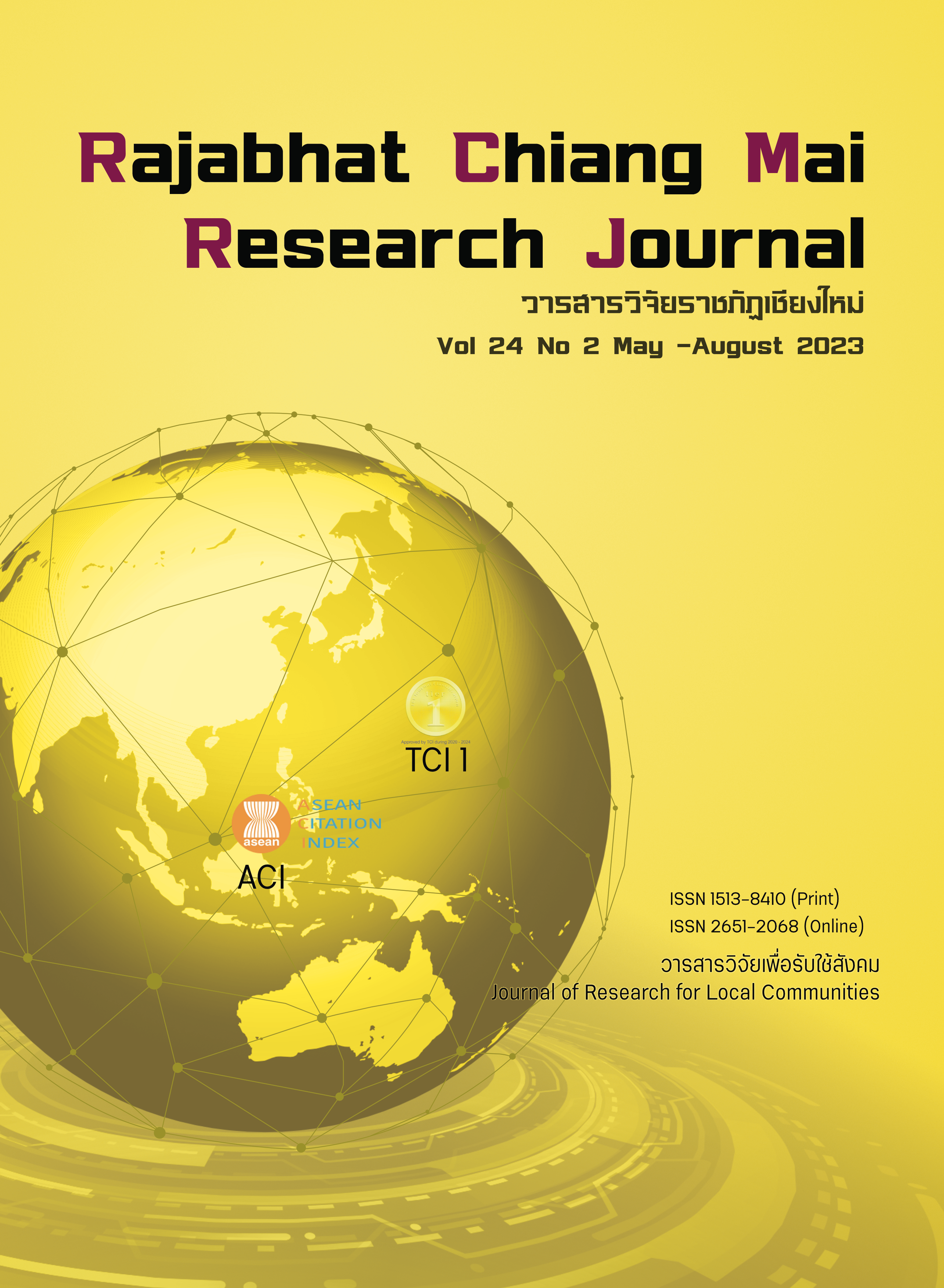Investigating the Relationship between Religious and Tourists' Perceptions of Temple Visitation Experience: Evidence from Phra Nakhon District Bangkok
DOI:
https://doi.org/10.57260/rcmrj.2023.264134Keywords:
Destination image, Experience, Satisfaction, Revisit intention, Word of mouth, Religious tourismAbstract
The objectives of this research are 1) to analyze the differences in religious tourism behaviors of Thai tourists in Phra Nakhon District, 2) to develop a structural equation model of religious tourism behaviors of Thai tourists. Data was collected, by using accidental sampling technique, with a sample of 400 people who were tourists and came to visit temples.
The results revealed that the relative chi-square (CMIN / DF) is 1.978, the conformity index GFI is 0.938, the CFI of the comparative conformity index CFI (Comparative Fit Index) is 0.980, (NFI) is 0.961 and the expected shift (RMSEA) is 0.050.
The results of the hypothesis testing which scrutinized the causal influence of image variables on experience, showed a significant direct impact. Furthermore, the experience component directly influences the satisfaction component. Additionally, the elements contributing to the willingness to spread the word were found to be statistically significant at the 0.001 level. This includes the importance of constructing floor features, such as ramps, to accommodate the needs of elderly tourists.
Downloads
References
Abbate, C. S., Nuovo, S. D. (2013). Motivation and personality traits for choosing religious tourism: A research on the case of Medjugorje, Current Issues in Tourism, 16(5), 501-506. https://doi.org/10.1080/13683500.2012.749844
Arbuckle, J. L. (2016). IBM SPSS Amos 22 user’s guide. Mount Pleasant, SC: Amos Development Corporation.
Argyle, M. (2002). The psychology of happiness Methuen, London .
Arndt, J. (1967). Role of product-related conversations in the diffusion of a new product. J. Mark. Res, 4, 291–295. https://doi.org/10.2307/3149462
Askin, D. (2012). Religious tours and spiritual travel Retrieved, The Independent Traveler, Retrieved from http://www.independenttraveler.com/travel-tips/none/religious-tours-and-spiritual-travel
Badone, E., & Roseman, S. (2004). Intersecting journeys: The anthropology of pilgrimage and tourism, University of Illinois, Urbana, IL.
Beerli, A., & Martin, J. D. (2004). Factors influencing destination image. Annals of Tourism Research, 31(3), 657-681. https://doi.org/10.1016/j.annals.2004.01.010
Belhassen, Y., Caton, K., & Stewart, W.P. (2008). The search for authenticity in the pilgrim experience. Annals of Tourism Research, 35(3), 668-689. https://doi.org/10.1016/j.annals.2008.03.007
Brown, J., Broderick, A. J., & Lee, N. (2007). Word of mouth communication within online communities: conceptualizing the online social network. J. Interact. Mark, 21, 2–20. DOI:10.1002/dir.20082
Buhalis , D. & Law, R. (2008). Progress in information technology and tourism management: 20 years on and 10 years after the internet the state of e-tourism research, Tourism Management, 29(4), 609-623. https://doi.org/10.1016/j.tourman.2008.01.005
Chen, C. F. & Tsai, D. C. (2007). How destination image and evaluate factors affect behavioral intentions, Tourism Management, 28, 1115- 1122.
Chen, J. S., & Uysal, M. (2002) Market positioning analysis: A hybrid approach, Annals of Tourism Research, 29(4), 987-1003.
Chuah, S. H., Rauschnabel, P. A., Marimuthu, M., Thurasamy, R., & Nguyen, B. (2017). Why do satisfied customers defect? A closer look at the simultaneous effects of switching barriers and inducements on customer loyalty, Journal of Service Theory and Practice, 27(3), 616–641. DOI:10.1108/JSTP-05-2016-0107
Cohen, E. (1979). A phenomenology of tourist experiences Sociology, 13(2), 179-201. https://doi.org/10.1177/00380385790130020
Cohen, J. (1977). Statistical power analysis for the behavioral sciences. New York: Academic.
Collins-Kreiner, N. (2010). Researching pilgrimage: Continuity and transformations. Annals of Tourism Research, 37(2), 440-456. https://doi.org/10.1016/j.annals.2009.10.016
Dawi, N. M., Jusoh, A., Streimikis, J., & Mardani, A. (2018). The influence of service quality on customer satisfaction and customer behavioral intentions by moderating role of switching barriers in satellite pay TV market. Economics and Sociology, 11(4), 198-218. DOI: 10.14254/2071-789X.2018/11-4/13
Dellarocas, C. (2003). The digitization of word of mouth: promise and challenges of online feedback mechanisms. Manag. Sci, 49(10), 1407–1424. DOI: 10.1287/mnsc.49.10.1407.17308
Faul, F., Erdfelder, E., Lang, A. G., & Buchner, A., (2007). G*Power 3: A flexible statistical power analysis program for the social, behavioral, and biomedical sciences. Behavior Research Methods, 39(2), 175-191. DOI:10.3758/BF03193146
Faul, F., Erdfelder, E., Buchner, A., & Lang, A. G. (2009). G*Power 3.1: Tests for correlation and regression analysis. Behavior Research Methods, 41(4), 1149-1160. http://dx.doi.org/10.3758/BRM.41.4.1149
Fletcher. S. K.. (2004). Religion and life meaning: Differentiating between religious beliefs and religious community in constructing life meaning. Journal of Aging Studies, 18(2), 171-185. https://doi.org/10.1016/j.jaging.2004.01.005
Gabor. M. T. (2016). Faith-based tourism. Business Mirror. Retrieved from http://www.businessmirror.com.ph/faith-based-tourism/
Gallarza, M. G., Saura, I. G., & García, H. C. (2002). Destination image: Towards a conceptual framework. Annals of Tourism Research, 29(1), 56-78. https://doi.org/10.1016/S0160-7383(01)00031-7
Giles, E. L., Bosworth, G., & Willett, J. (2013). The role of local perceptions in the marketing of rural areas, Journal of Destination Marketing & Management, 2(1), 4-13. https://doi.org/10.1016/j.jdmm.2012.11.004
Harris, D. (2004). Key concepts in leisure studies Sage, The Cromwell Press, London.
Henderson, K., Frelke, C. E. (2000). Space as a vital dimension of leisure: The creation of place. World Leisure, 42(3), 18-24. DOI:10.1080/04419057.2000.9674192
Huang, K., Pearce, P. L., & Wen, J. (2017). Tourists' attitudes toward religious commercialization. Tourism Culture & Communication, 17(4), 259-270. https://doi.org/10.3727/109830417X15072926259397
Jacobsen, J. K. S., & Munar, A. M. (2012). Visitor information search and destination choice in a digital age0. Tourism Management Perspectives, 1, 39-47. https://doi.org/10.1016/j.tmp.2011.12.005
Kasim, A. (2011).Balancing tourism and religious experience: Understanding devotees' perspectives on Thaipusam in Batu Caves, Selangor, Malaysia Journal of Hospitality Marketing & Management, 20(3–4), 441-456. https://doi.org/10.1080/19368623.2011.562437
Kim, H., & Richardson, S. L. (2003). Motion picture impacts on destination images. Annals of Tourism Research, 30(1), 216-237. https://doi.org/10.1016/S0160-7383(02)00062-2
Litvin, S. W., Goldsmith, R. E., & Pan, B. (2008). Electronic word-of-mouth in hospitality and tourism management. Tour. Manage. 29(3), 458-468. https://doi.org/10.1016/j.tourman.2007.05.011
Loureiro, S. M. C. (2014). The role of the rural tourism experience economy in place attachment and behavioral intentions. International Journal of Hospitality Management, 40, 1–9. https://doi.org/10.1016/j.ijhm.2014.02.010
Marchiori, E., & Cantoni, L. (2015). The role of prior experience in the perception of a tourism destination in user-generated content. Journal of Destination Marketing & Management, 4(3), 194-201. https://doi.org/10.1016/j.jdmm.2015.06.001
Martensen, A., & Grønholdt, L. (2016). The effect of word-of-mouth on consumer emotions and choice: Findings from a service industry", International Journal of Quality and Service Sciences, 8(3), 298-314. DOI:10.1108/IJQSS-04-2016-0037
Martin, H. S., & Bosque, I. R. D. (2008). Exploring the cognitive–affective nature of destination image and the role of psychological factors in its formation. Tourism Management, 29(2), 263-277. https://doi.org/10.1016/j.tourman.2007.03.012
Mazumdar, S., & Mazumdar, S. (2004). Religion and place attachment: A study of sacred places Journal of Environmental Psychology, 24(3), 385-397. https://doi.org/10.1016/j.jenvp.2004.08.005
Neuhofer, B., & Buhalis, D. (2014). Experience, co-creation and technology: Issues, challenges and trends for technology enhanced tourism experiences In: S. McCabe (Ed.), The Routledge handbook of tourism marketing. (pp. 124–139).
Nisco, A. D, Mainolfi, G., Marino, V., & Napolitano, M. R. (2015). Tourism satisfaction effect on general country image, destination image, and post-visit intentions, Journal of Vacation Marketing, 21(4), 305–317. https://doi.org/10.1177/135676671557750
Oktadiana, H., & Pearce, P. L., & Chon, K. (2016). Muslim travellers' needs: What don't we know, Tourism Management Perspectives, 20 , 124-130. https://doi.org/10.1016/j.tmp.2016.08.004
Olya, H. G., & Al-ansi, A. (2018). Risk assessment of halal products and services: Implication for tourism industry. Tourism Management, 65, 279–291. https://doi.org/10.1016/j.tourman.2017.10.015
Otto, J. E., & Ritchie, J. R. B. (1996). The Service Experience in Tourism. Tourism Management, 17(3), 165-174. http://dx.doi.org/10.1016/0261-5177(96)00003-9
Qu, H., Kim, L. H., & Im, H. H. (2011). A model of destination branding: Integrating the concepts of the branding and destination image. Tourism Management, 32(3), 465-476. DOI: 10.1016/j.tourman.2010.03.014
Pearce, P. L. (2011). Tourist behaviour and the contemporary world Channel View. Bristol: UK.
Pearce, P. L., Wu, M.-Y., Carlo, M. D., & Rossi, A. (2013). Contemporary experiences of Chinese tourists in Italy: An onsite analysis in Milan. Tourism Management Perspectives, 7, 34-37. https://doi.org/10.1016/j.tmp.2013.04.001
Pearce, P. L., & Pabel, A. (2015). Tourism and humour Channel View. Bristol: UK.
Pearce, P. L. (2005). Tourist behaviour: Themes and conceptual schemes. Channel View, Clevedon.
Poria, Y., Butler, R., & Airey, D. (2003).Tourism, religion and religiosity: A holy mess. Current Issues in Tourism, 6(4), 340-363. https://doi.org/10.1080/13683500308667960
Poria, Y., Reichel, A., Biran, A. (2006). Heritage site management: Motivations and expectations. Annals of Tourism Research, 33(1), 162-178. https://doi.org/10.1016/j.annals.2005.08.001
Prayag, G., Hosany, S., Muskat, B., & Del Chiappa, G. (2017). Understanding the relationships between tourists’ emotional experiences, perceived overall image, satisfaction, and intention to recommend. Journal of Travel Research, 56(1), 41–54. https://doi.org/10.1177/0047287515620567
Raj, R., & Morpeth, N. D. (2007). Religious tourism and pilgrimage festivals management: An international perspective CABI, Wallingford.
Sharpley, R., & Sundaram, P. (2005). Tourism: A sacred journey? The case of ashram tourism, India. International Journal of Tourism Research, 7(3), 161-171. DOI:10.1002/jtr.522
Shoemaker, S., & Lewis, R. C. (1999). Customer loyalty: the future of hospitality marketing. International. Journal of Hospitality Management, 18(4), 354-370. https://doi.org/10.1016/S0278-4319(99)00042-0
Singh, S. (2004). Religion, heritage and travel: Case references from the Indian Himalayas. Current Issues in Tourism, 7(1), 44-65. https://doi.org/10.1080/13683500408667972
Sinjaru, T. (2020). Research and analysis of statistical data with SPSS and AMOS. 18thed. Bangkok: R&D Business Ordinary Partnership. (In Thai)
Son, A., & Pearce, P. L. (2005). Multi-faceted image assessment. Journal of Travel & Tourism Marketing, 18(4), 21-35. DOI:10.1300/J073v18n04_02
Stabler, M. J. (1995).The image of destination regions: Theoretical and empirical aspects B. Goodall, G. Ashworth (Eds.), Marketing in tourism industry: The promotion of destination regions, Routledge: London, 133-159.
Stokowski, P. A. (2002). Languages of place and discourses of power: Constructing new sense of place. Journal of Leisure Research, 34(4), 368-382. https://doi.org/10.1080/00222216.2002.11949977
Trauer, B., & Ryan, C. (2005). Destination image, romance and place experience: An application of intimacy theory in tourism, Tourism Management, 26(4), 481-491. https://doi.org/10.1016/j.tourman.2004.02.014
Tung, V. W. S., & Ritchie, J. R.(2011).Exploring the essence of memorable tourism experiences. Res., 38(4), 1367-1386. https://doi.org/10.1016/j.annals.2011.03.009
Walmsley, D. J., & Young, M. (1998). Evaluative images and tourism: The use of personal constructs to describe the structure of destination images, Journal of Travel Research, 36(3), 65-69. https://doi.org/10.1177/004728759803600307
Williams, D. R. (2002). Leisure identities, globalization, and the politics of place, Journal of Leisure Research, 34(4), 351-367. https://doi.org/10.1080/00222216.2002.11949976
Wong, C. U. I., Ryan, C., & McIntosh, A. (2013). The monasteries of Putuoshan, China: Sites of secular or religious tourism, Journal of Travel & Tourism Marketing, 30(6), 577-594. https://doi.org/10.1080/10548408.2013.810996
Yagi , C., & Pearce, P. L. (2007). The influence of appearance and the number of people viewed on tourists' preferences for seeing other tourists. Journal of Sustainable Tourism, 15(1), 28-43. https://doi.org/10.2167/jost528.0
Downloads
Published
How to Cite
Issue
Section
License
Copyright (c) 2023 Rajabhat Chiang Mai Research Journal

This work is licensed under a Creative Commons Attribution-NonCommercial-NoDerivatives 4.0 International License.
1. Articles, information, content, images, etc published in the “Community and Social Development Journal” are copyrighted by the Community and Social Development Journal, Chiang Mai Rajabhat University. In order to properly distribute the articles through print and electronic media, the authors still hold the copyright for the published articles under the Creative Commons Attribution (CC BY) license, which allows the re-distribution of the articles in other sources. References must be made to the articles in the journal. The authors are responsible for requesting permission to reproduce copyrighted content from other sources.
2. The content of the articles appearing in the journal is the direct responsibility of the article authors. The editorial board of the journal does not necessarily agree with or share any responsibility.














